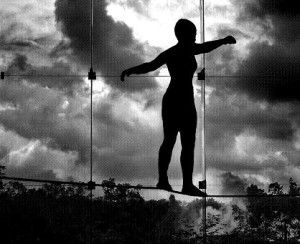Balance
 November 28th, 2011
November 28th, 2011  Todd
Todd It takes just 5 minutes to improve your balance
Guest post by Kate Wilsson.
How does it feel to stand tip-toed on a champagne bottle? Never tried it! It should never be tried unless you are an expert. This demands great skill. Balancing is one aspect which usually gets ignored by majority. While strength and endurance are integral aspects of fitness, balance is also vital. It might be surprising to know that only five minutes of regular practice can improve your balance for the good.
Balancing your body
The vestibular system is responsible for balancing the body. This mechanism in your inner ear tells you when you start wobbling, and how much and in which direction you may fall. An array of body systems follows the sensory information from the nerves and muscles. When sensory receptors start failing, balance may start declining. In aged persons, balance may worsen as they become less fit. The brain, muscles and bones collaborate to give the body balance and avoid falling. Balance can be improved considerably by becoming more sensitive to the vestibular system.
Enhanced balance not only improves your coordination and posture but also gives you a feel of grace. Fitness training can include the vestibular system gradually after strength exercises. Good balance can benefit in diverse ways like reducing injury risk and strengthening joints. Besides the enhanced sports performance, this also enables improved overall daily function.
The human body frequently changes its center of gravity and leads to wobbling. When you are perfectly balanced, the center of gravity shall be exactly above where you touch the base. The idea behind keeping balance is to realize when you start wobbling. If you can observe the variation timely, you can control it. But if you delay, it will increase the chances of falling. In other words, you have to learn to experience your vestibular system better.
A simple test
People who are physically active less regularly may exhibit poor balance. It has been observed that hikers, avid runners, cyclists (and many similar others) also may have poor balance.
You can perform a simple test to assess your balance. Stand straight or use a wall for help (to lean on). Determine the duration you can stand on one leg. If you wobble a lot or feel unstable, your balance needs to improve. A thirty second uninterrupted balance is okay. If it is less than that, you have to work upon your balance. Balancing on one leg can be easier than the opposite leg.
Some find it difficult to balance with closed eyes. Possibly, they link balance to eyes. Closed eyes tend to lose their balance, possibly causing accidents.
How to Improve Your Balance
Balancing can, thankfully, be improved with practice. Training and practice enables the body to feel the slightest sense of instability and automatically correct thereafter.
First stage
Begin practicing by standing on one leg as long as possible. Keep your head moving side to side and up and down simultaneously. To enable body balance, shift your eye focus quickly. Do not allow your eyes to concentrate on one thing for more than a second. When you can remain stable for one minute, proceed to the second stage.
Second stage
In this stage you have to balance on one leg and play with a ball. While balancing on one leg, throw the ball against the wall and catch it. You can do this yourself or engage friend join in. Your body will learn to balance while your focus is on catching the ball. This technique is very helpful in sharpening the balance autopilot.
Third stage
You may have played this one sometime as a child. You may not have realized the benefit it brings. Balance on one leg. Hop into the air to land on another leg (never rest the two together). Take your time to be stable when changing legs. Repeat this continuously for 3-5 minutes (without faltering). When you have gained the skill, call your friend and play catch with her while hopping around.
Conclusion
Just five minutes of practice each day can contribute to improve your balance considerably. But it takes time to gain the skill. Do not move on to the next stage before you are certain you can handle it. Perseverance and practice are the keywords.
About the author: Kate is a blogger and writer. She loves writing about the environment and technology. She is fond of books on home remedies, and skin care tips. These days she is busy in writing about exercise equipment for her blog.
Photo: Kristin Smith
You can leave a response, or trackback from your own site.

 Posted in
Posted in  Tags:
Tags:
November 29, 2011 at 10:19 am
Balance was no big deal to me until I realized I didn’t really have it. My fitness routines have done so much to change all that, but what bugs we is when I do a balancing move one day, and it’s awesome, but then I’ll do that same exact move on another day, and I’m all wobbly ‘n stuff. Maybe I just need more practice.
Yum Yucky´s latest work of art [type] ..Sugary Sh!t Detector
November 29, 2011 at 10:35 am
I find the same thing on those odd days that I do yoga. One day I’m rockin’ some particular pose, and the next time it’s all I can do to keep from landing on my beak.